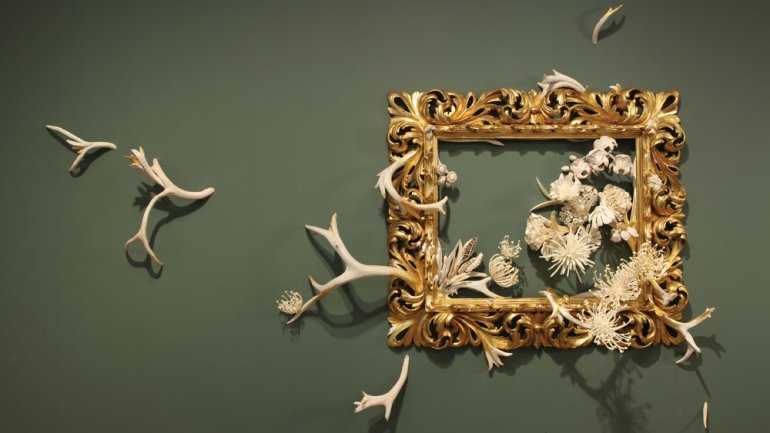Why Innovation Matters
Why Innovation Matters
This past spring, Museum of Arts and Design chief curator David Revere McFadden helped jury the biennial “ArtQuilt Elements” exhibition at Pennsylvania’s Wayne Art Center. Just before the opening of the exhibition, he and his fellow jurors discussed their process for jurying the show with the audience of the Studio Art Quilt Associates and Surface Design Association conference. McFadden touched on the value of aesthetic progress in craft mediums, the “provocative” factor that makes work memorable, the need to move beyond tradition (perhaps while still reflecting it), and the challenge of technology for artists who aren’t altogether comfortable with it. His remarks caused a stir. One attendee who blogged afterward asked, “When does innovation become gimmick? Why push to use new materials if it doesn’t say anything?” We asked McFadden to explain and to share images of works he considers particularly innovative.
You struck a nerve at the SAQA/SDA conference when you said you were dismayed that none of the quilts submitted to the show incorporated fiber optics, digital technology, or video. Why was that so disappointing to you?
I think we are living through an amazing period in history, when new technologies are shaping our visions and our potential. While I have a limitless respect for all of the traditional craft techniques and deeply admire those who have honed their skills to an extraordinary degree, I am also interested in how new digital technologies, both in design and fabrication, are opening up new possibilities for creating work that has powerful visual appeal and intellectual content. Younger artists in all media are making use of rapid prototyping techniques, CAD and CAM programs, fiber optics, and video to expand their repertoire.
Our era is probably as exciting and as threatening as the first time someone introduced the newfangled machines that came to be called the weaving loom and the turning lathe. Practitioners of every medium, including quilting, need to be aware that things are changing and that there is an exciting new world out there waiting to be discovered. Sadly, none of this excitement made it into the competition, and I missed it.
You told conference-goers that you felt like you were in a time warp, looking at pieces that could have been made 30 years ago. In your view, does innovation entail aesthetics as much as materials?
Innovation happens on many levels: aesthetic, technical, material. Innovation can materialize when artists have given rigorous thought to what they are doing, why they are doing it, and how they are doing it. For an old curator like me, it seems that one just recognizes innovation even when no specific source or component can be recognized. Maybe innovation is like pornography: You know it when you see it.
Do you think some mediums, such as quiltmaking, are naturally more focused on tradition than others? Does that mean they should be judged differently from other forms?
I don’t think there is a medium that does not have a history. Even digital technologies have been around long enough to yield a pretty impressive family tree of ideas, concepts, and techniques. Quiltmaking does have a distinctive history, for certain, in that it grows out of a functional tradition and a long-standing history of handwork. That said, artists and designers keep creating new vases, new chairs, new cutlery, as well as sculpture, fountains, and wearable ornament. No medium should have its own criteria of quality and importance based on the fact that it has a history. The key for quiltmakers – and all artists – is to use their format to make excellent, not mediocre, art.
You’ve said that as a curator, you look for memorable work. Can a piece be traditional but also memorable, or is innovation key to being memorable?
What grabs my attention and sticks in my memory is something viscerally perceived – something beautiful and meaningful. Some of the most traditional things are incredibly memorable, but so too are total surprises that kick the stool out from underneath your expectations and stereotypes.
You told a funny story at the conference about having once tried embroidery and ending up embroidering your work to your pants. How important is it for a juror to be well-versed in the mechanics of the art form he is judging?
While I think it always is a plus to know the technical side of making things to better appreciate their virtues, it certainly cannot be mandatory. If that were true, by now I would have done a lot more damage to myself than embroidering into my pants – I would have burned off my feet with molten glass, sawed off my fingers on a bandsaw, and strangled myself with macramé yarn.
Is there a generational aspect to innovation? Are young artists simply more likely to be innovative?
I fear it’s rather true that younger people seem to be more open to experimenting and testing the water, especially in today’s world of instant communication, liberated images, and immediate visual and intellectual gratification. It is the dual-edged nature of youth – a willingness to take chances and make mistakes. Sometimes the mistakes are horrifying, but one can look ahead to many more years of fruitful work.
At the same time, of course, there are “mature” artists who are as innovative as any, who have come to terms with their own mistakes and gotten over them. They have learned to forgive their own failures and keep on creating. Was it Lily Tomlin who said that forgiveness is giving up hope for a better past?
Monica Moses is American Craft’s editor in chief.




